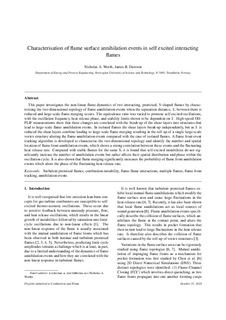| dc.contributor.author | Worth, Nicholas | |
| dc.contributor.author | Dawson, James | |
| dc.date.accessioned | 2019-02-21T12:43:52Z | |
| dc.date.available | 2019-02-21T12:43:52Z | |
| dc.date.created | 2018-11-09T09:12:07Z | |
| dc.date.issued | 2018 | |
| dc.identifier.issn | 0010-2180 | |
| dc.identifier.uri | http://hdl.handle.net/11250/2586782 | |
| dc.description.abstract | This paper investigates the non-linear flame dynamics of two interacting, premixed, V-shaped flames by characterising the two-dimensional topology of flame annihilation events when the separation distance, S, between them is reduced and large-scale flame merging occurs. The equivalence ratio was varied to promote self-excited oscillations, with the oscillation frequency, heat release phase, and stability limits shown to be dependent on S. High-speed OH-PLIF measurements show that these changes are correlated with the break-up of the shear layers into structures that lead to large-scale flame annihilation events. In isolated flames the shear layers break-up independently, but as S is reduced the shear layers combine leading to large-scale flame merging resulting in the roll up of a single large-scale vortex structure altering the flame annihilation events compared with the case of isolated flames. A flame front event tracking algorithm is developed to characterise the two-dimensional topology and identify the number and spatial location of flame front annihilation events, which shows a strong correlation between these events and the fluctuating heat release rate. Compared with stable flames for the same S, it is found that self-excited instabilities do not significantly increase the number of annihilation events but rather affects their spatial distribution and phase within the oscillation cycle. It is also shown that flame merging significantly increases the probability of flame front annihilation events which alters the phase of the fluctuating heat release rate. | nb_NO |
| dc.language.iso | eng | nb_NO |
| dc.publisher | Elsevier | nb_NO |
| dc.rights | Attribution-NonCommercial-NoDerivatives 4.0 Internasjonal | * |
| dc.rights.uri | http://creativecommons.org/licenses/by-nc-nd/4.0/deed.no | * |
| dc.title | Characterisation of flame surface annihilation events in self excited interacting flames | nb_NO |
| dc.title.alternative | Characterisation of flame surface annihilation events in self excited interacting flames | nb_NO |
| dc.type | Journal article | nb_NO |
| dc.type | Peer reviewed | nb_NO |
| dc.description.version | acceptedVersion | nb_NO |
| dc.source.journal | Combustion and Flame | nb_NO |
| dc.identifier.doi | https://doi.org/10.1016/j.combustflame.2018.10.032 | |
| dc.identifier.cristin | 1628577 | |
| dc.description.localcode | © 2018.This is the authors’ accepted and refereed manuscript to the article. Locked until 08.11.2020 due to copyright restrictions. This manuscript version is made available under the CC-BY-NC-ND 4.0 license http://creativecommons.org/licenses/by-nc-nd/4.0/ | nb_NO |
| cristin.unitcode | 194,64,25,0 | |
| cristin.unitname | Institutt for energi- og prosessteknikk | |
| cristin.ispublished | true | |
| cristin.fulltext | preprint | |
| cristin.qualitycode | 2 | |

